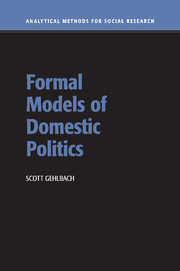1 - Electoral Competition under Certainty
Published online by Cambridge University Press: 05 March 2013
Summary
We begin with models of electoral competition. This chapter explores electoral competition when voting behavior is deterministic; the following chapter considers electoral competition under uncertainty.
A frequent assertion in two-party systems is that there is little substantive difference between the positions chosen by the parties. The economist Harold Hotelling was the first to offer a theoretical explanation for this phenomenon (Hotelling, 1929). Parties, Hotelling argued, choose positions along a left-right continuum (an example of a policy space), much as gas stations or drug stores choose a location along Main Street. When there are two parties, the logic of political competition compels each to adopt a position in the center of the ideological spectrum, just as we often observe gas stations located across the street from each other in the center of town. Anthony Downs popularized and extended Hotelling's argument in An Economic Theory of Democracy (Downs, 1957).
We thus initiate our discussion of electoral competition with the Hotelling-Downs model, where parties adopt positions to maximize their probability of winning. We then take up an alternative model in which parties are motivated not to win office for its own sake, but to achieve the best possible policy outcome. Following this, we explore electoral competition when more than two parties compete. Finally, we endogenize the number of parties (or candidates) in the election by considering various models of entry.
- Type
- Chapter
- Information
- Formal Models of Domestic Politics , pp. 1 - 26Publisher: Cambridge University PressPrint publication year: 2013



